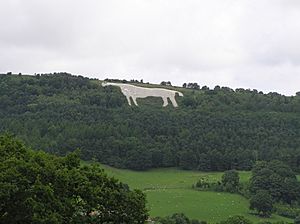Kilburn White Horse facts for kids
The Kilburn White Horse is a giant horse shape carved into a hillside in the North York Moors National Park in England. It's close to a village called Kilburn, North Yorkshire. This amazing figure is about 318 feet (97 meters) long and 220 feet (67 meters) high. It covers an area of about 1.6 acres (6,500 square meters). People say it's the biggest and most northerly hill figure in all of England!
Contents
Where to See the Kilburn White Horse
The White Horse is located on the southern side of Sutton Bank. This area is part of the Hambleton District. The horse faces south-south-west, which means you can see it from far away.
- From the Railway: If you're on the East Coast Main Line railway south of Thirsk, you might spot it.
- From the Road: It's also visible from the A19 road.
- From Leeds: On a clear day, you can even see the horse from north Leeds, which is about 28 miles (45 km) away! This is because Leeds is on higher ground to the west of the Vale of York.
How the White Horse Was Made
The hillside at Sutton Bank is made of sandstone. To create the horse, people removed the top layer of soil. This showed the rock underneath. Then, they covered the exposed rock with white limestone chips to make the horse stand out.
- When it was Made: The Kilburn White Horse was created in November 1857.
- Who Made It: Some stories say that a school master named John Hodgson and his students helped make it. Local volunteers also joined in.
- Thomas Taylor's Idea: A man named Thomas Taylor, who was from Kilburn, was the main person behind the idea. He worked as a buyer in London. He was inspired after seeing celebrations at the Uffington White Horse in 1857. He wanted his home village to have a similar amazing figure.
- Hard Work: Thirty-three men worked together to cut the horse shape. They used about 6 tons (6.1 metric tonnes) of lime to make the exposed rock white.
Looking After the White Horse
Today, the Kilburn White Horse is made of off-white limestone chips. Because the hillside is very steep, especially at the horse's chest and front legs, the chips can sometimes slide down. To stop this, special boards have been put in place to hold them.
- Restoration Fund: In 1925, people donated money to a special fund to help restore the horse. The money left over, about £100, was invested. This money helps pay for the horse to be "groomed" every three years. This means they clean and maintain it to keep it looking good.
Visiting the White Horse
There's a car park below the White Horse. You can find a footpath that goes up past the horse and even crosses right above it.
- Best Views: The best place to see the White Horse is from the Bagby road. There are benches there where you can sit and enjoy the view.
- View from the Horse: The footpath also offers a beautiful view of the surrounding area from the horse itself.
The White Horse During World War II
During World War II, the Kilburn White Horse was covered up. This was done to stop it from being an easy landmark for enemy bombers to see from the sky.
Interesting Facts
- Some people say this white horse can be seen from Julian's Bower in North Lincolnshire. That's over 45 miles (72 km) away!
- The horse was even featured in a video for the launch of Channel 3 North East in 1996. This was a new name for the TV station Tyne Tees Television.
Images for kids





